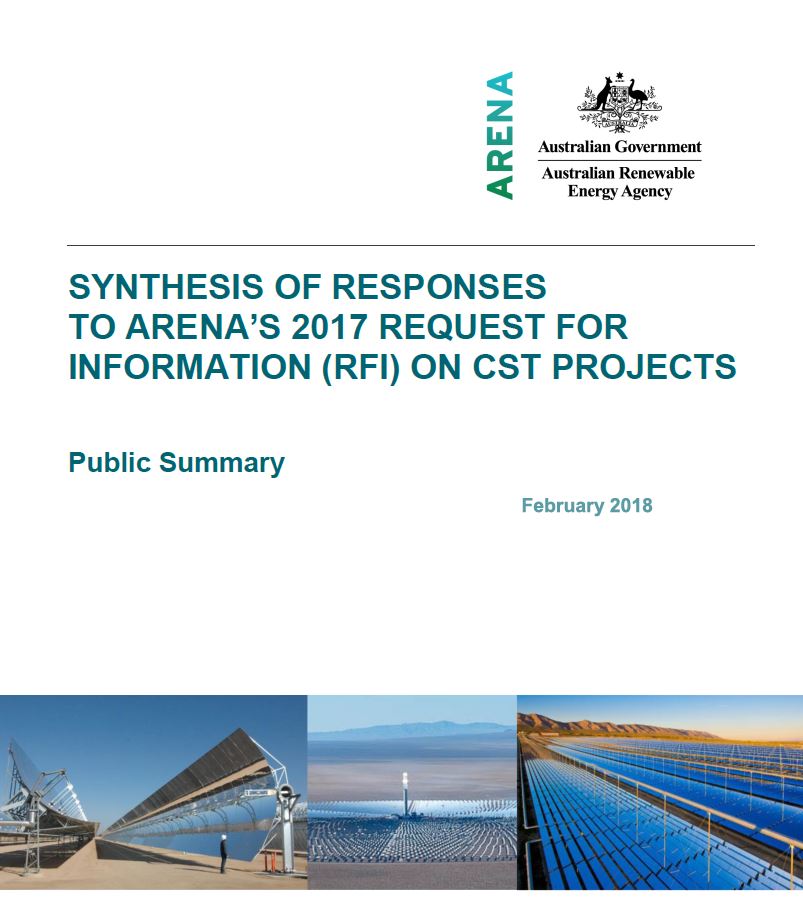
08 Mar ARENA report: Paving the way for concentrated solar thermal in Australia
The Australian Renewable Energy Agency (ARENA) today released a report outlining how concentrated solar thermal (CST) technology could be a commercially viable form of dispatchable renewable energy within a decade.
Last year, ARENA called for industry participants worldwide to respond to a Request for Information (RFI) exploring the potential for solar thermal to be rolled out in Australia. A total of 31 responses were received from both Australian and international companies.
These responses will now inform ARENA in preparing a strategy to support CST in Australia, including considering future funding opportunities for CST.
ARENA is also funding a roadmap for CST to examine requirements for accelerating commercial deployment in Australia. The roadmap is underway and will be completed in mid 2018, with the results also used to inform ARENA’s CST strategy.
CST systems use mirrors to concentrate and convert sunlight to heat at high temperatures. The heat is then stored and used to produce steam, which is then run through a turbine to generate electricity. Most CST plants are large scale and incorporate between 3-15 hours of thermal energy storage.
Large scale CST technology is yet to be introduced in Australia, but there are approximately 100 utility scale CST plants operating worldwide, mostly in the United States and Spain totalling around 5GW. The total CST capacity is expected to double to 10 GW over the next five years, driven by new plants in China, South America and Africa.
The report released today, which was prepared by ITP Thermal, found strong confidence in the future of CST, with a number of global industry leaders interested in being involved in the deployment of CST in Australia.
All responses highlighted that CST could help to address Australia’s energy storage and dispatchability needs by providing reliable, responsive and flexible electricity generation at any time of day or night. Respondents noted that CST plants operate in a way similar to that for existing thermal power stations, allowing them to be easily incorporated within the electricity network. Respondents also noted the cost of CST is expected to fall in the coming years.
ARENA CEO Ivor Frischknecht said the RFI was an important stepping stone towards bringing commercial scale CST to Australia.
“While still not cost-competitive with other forms of new-build power generation, the ability to store energy and be able to dispatch renewable energy at any time will be of increasing value, and this information shows there is strong support for CST,” he said.
“We are now considering funding opportunities to assist in creating a pathway for CST to become commercially viable in Australia in the coming years,” Mr Frischknecht said.
In the meantime, Mr Frischknecht said ARENA welcomes applications for a well developed CST project under ARENA’s Advancing Renewables Program which provides funding for renewable energy projects year-round.
“While we are busy working out our roadmap for the industry, our door is always open to high quality, innovative renewable energy demonstration projects that can help bridge the gap to commerciality for new technologies.
“If any company has a prospective project with well developed financing, an offtake agreement and technical details mapped out, they don’t need to wait and we would encourage them to apply,” he said.
ARENA is also currently working with the Clean Energy Finance Corporation (CEFC), in consultation with the Infrastructure and Project Financing Agency (IPFA), to provide the Commonwealth Government with advice on Solar Reserve’s 150MW Aurora CST project proposed for Port Augusta, including its suitability for a federal loan of $110 million.
Download this media release
Read the CST Report



